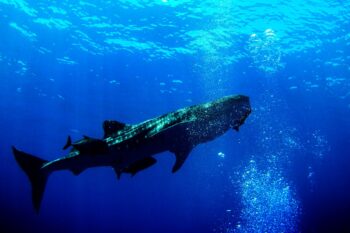Whale Shark Season in the Yucatan Peninsula: May to September
Every year, the majestic whale sharks migrate from open waters to the Yucatan Peninsula between May and September. During this season, these incredible creatures can be spotted in the clear waters near Cancun, Contoy Island, Isla Mujeres, and Holbox Island. This annual migration occurs as they come to feed in the nutrient-rich waters, offering a unique opportunity for nature enthusiasts and tourists to witness them up close.

Whale Shark Tours: Swim and Dive in Cancun, Isla Mujeres, and Holbox
Looking for an unforgettable experience with the world’s largest fish? Some tours are available, departing from Cancun, Isla Mujeres, and Holbox. These guided tours offer a unique opportunity to swim and dive alongside the whale shark, a gentle giant that is a slow-moving, filter-feeding carpet shark. It is also the largest known fish species, with the largest confirmed individual measuring an impressive 18.8 meters in length. This creature holds several records in the animal kingdom, including being the largest living non-mammalian vertebrate.
Anatomy: Unique Features and Characteristics
The largest fish in the ocean, have a distinct and fascinating anatomy. They feature a broad, flattened cranium with a large mouth positioned at the front, unlike many other shark species whose mouths are on the underside. This adaptation allows them to filter-feed effectively as they swim. Researchers recorded a 12.1-meter (39.7-foot) whale shark with a mouth width of 1.55 meters (5.1 feet).
These gentle giants possess more than 300 rows of tiny teeth and 20 filter pads, which they use to filter plankton and small fish. The spiracles, or breathing openings, are located just behind their small eyes at the front corners of their head. This unique anatomy enables this fish to be an efficient filter feeder.







